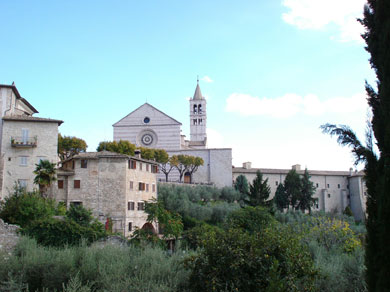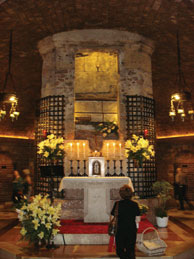
By Debbie Rodriquez
Pilgrims are moved by the conviction of roman martyrs and the beauty of Italy’s Basilicas.
Italy has long been a primary destination for catholic travelers seeking out their spiritual roots. With the Vatican, and the most powerful denomination in the world based in Rome, it is easy to understand why so many of the faithful have made the journey. In fact, religious tourism in Italy brings in more than 4.5 billion dollars each year. Within the last five to 10 years, many more Protestant Christians are becoming a part of that figure. They are discovering why this country provides such a powerful and tangible connection to their own faith.
 “The beginning of real Christianity is not in Jerusalem, it is in Rome,” says Dr. Gaetano Sottile, president and founder of Italy for Christ. Based in Rome, his organization presents the Gospel to Italians through evangelistic outreaches and by working with local churches. He also plays host to many American pastors who, along with members of their congregation, help with ministry outreaches while soaking up some early christian history.
“The beginning of real Christianity is not in Jerusalem, it is in Rome,” says Dr. Gaetano Sottile, president and founder of Italy for Christ. Based in Rome, his organization presents the Gospel to Italians through evangelistic outreaches and by working with local churches. He also plays host to many American pastors who, along with members of their congregation, help with ministry outreaches while soaking up some early christian history.
“All roads lead to Rome and from Rome we can reach the world,” Sottile says. He is passionate about the inspiration a trip to Italy provides believers and sees that many ministries are beginning to figure this out.
Christian martyrs of Rome“
“What a wonderful time for Christians to come to the Colosseum and experience the faith of the martyrs,” Sottile says. The Colosseum’s beauty hides its cruel history — one that was brutal for early Christians. A large cross now stands in the center of the structure, a powerful reminder of their faith and courage. Remembering the faith of the martyrs is a unique inspiration to be faithful until the end.
A must see highlight is a visit to the catacombs — the ancient underground Christian cemeteries that provide precious insight into the early church. It was here, during times of persecution, that Christians would hold worship services. There are more than 60 catacombs with hundreds of miles of labyrinth tunnels and tens of thousands of tombs. Today, five catacombs are open to the public and serve as an archive of the early church. Paintings, sculptures and symbolic engravings, such as the fish (the symbol of Christ) and the anchor (the symbol of salvation), decorate the walls of these tombs, all telling the story of early church doctrine and faith.
For many Christians a visit to the Mamertine prison is an unforgettable experience. The Apostle Paul was incarcerated here for preaching the Gospel. “The most moving place in Rome is where Paul was in prison because it’s the real prison, and when you’re there, you are so conscious of his commitment to christ,” says Norman Mccrummen, pastor of Spring Hill Presbyterian Church, Mobile, AL.
Mccrummen took 25 church members to Italy a few years ago and still remembers how it impacted his group. “I saw it in their faces and heard it in their comments,” he says. “The sense of awe that they were standing in that place; seeing them touch the stones of the walls and realizing these were the actual stones.”
“If you want to touch early Christianity, go to Rome” says Brian Zahnd, pastor of Word of Life church, St. Joseph, Mo. Zahnd has traveled the world during his more than 25 years of ministry. In January he visited Rome and Assisi and says it was the best trip he has ever taken. He has spent the last year studying the life of St. Francis of Assisi, and then made the meaningful journey to see it all firsthand.
to touch early Christianity, go to Rome” says Brian Zahnd, pastor of Word of Life church, St. Joseph, Mo. Zahnd has traveled the world during his more than 25 years of ministry. In January he visited Rome and Assisi and says it was the best trip he has ever taken. He has spent the last year studying the life of St. Francis of Assisi, and then made the meaningful journey to see it all firsthand.
St. Francis of Assisi
“We need to rescue St. Francis from Catholic exclusivity,” Zahnd says. “His conversion, his life, his impact upon society is profoundly inspirational. He is extraordinary, and it’s a shame that protestants haven’t been more aware of him.”
Assisi is a small town in Umbria, on the border of Tuscany in Central Italy. Although only 3,000 people call this picturesque hill town home, each year four to five million spiritual pilgrims fill it’s winding medieval streets, visiting the town’s main attraction — the Basilica of St. Francis. It was built as a memorial to him in the mid-1200s and his tomb rests there. This beautiful Basilica is one of the artistic and religious highlights of Europe, frescoed from top to bottom by the leading artists of the day.
“He was a reformer, a revivalist and a creative preacher. He was a proto evangelical, in the sense that he preached the Gospel in such a way as to expect people to be converted by it,” Zahnd says.
There are many places throughout Italy that are significant and meaningful to the believer. As the owner of Journeys of Faith tours, Wildwood, MO, a company specializing in Christian Heritage Tours of Europe, I have found that most of my customer inquiries are about trips to Italy, rather than the traditional hotspot for European Christian travel — Germany.
 Reformation history buffs can trace its roots back to Italy. They need only look at early church reformers like Girolamo Savonarola, who was martyred in Florence in 1498, St. Francis of Assisi and peter Waldo from France. Waldo’s amazingly enlightened biblical teachings in the 12th century became the foundation for the Waldensian Christian Church. These persecuted Christians fled to northwestern Italy, where thousands still live today. And of course it was while he was visiting Rome and climbing the Scala Santa (Holy stairs) on his knees, that Martin Luther first began to question his own beliefs — questions that would ultimately lead to his launching of the reformation in 1517.
Reformation history buffs can trace its roots back to Italy. They need only look at early church reformers like Girolamo Savonarola, who was martyred in Florence in 1498, St. Francis of Assisi and peter Waldo from France. Waldo’s amazingly enlightened biblical teachings in the 12th century became the foundation for the Waldensian Christian Church. These persecuted Christians fled to northwestern Italy, where thousands still live today. And of course it was while he was visiting Rome and climbing the Scala Santa (Holy stairs) on his knees, that Martin Luther first began to question his own beliefs — questions that would ultimately lead to his launching of the reformation in 1517.
“So where did the whole thing start? Right here in Rome,” Sottile says. And those who decide to make the journey will find it well worth their while.


